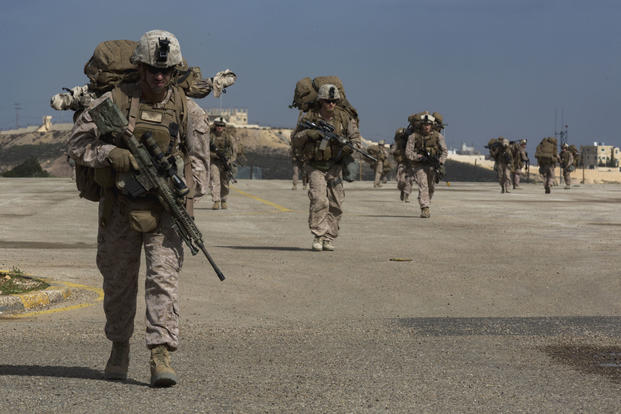U.S. Marines, attached to special operations forces in Syria, often found themselves in direct-fire gunfights with Islamic State fighters earlier this year, according to the commander of the Special-Purpose Marine Air-Ground Task Force-Crisis Response for Central Command.
The unit, designed with capability to launch combat forces within six hours anywhere in the CENTCOM theater, sent two rifle companies to support Special Operations Command units operating in Northern Syria between January and April, Marine Col. Christopher Gideons, commander of the task force, said Friday at the Potomac Institute.
"When Marines deploy, they want to get involved," he said. "When there is a gunfight out there ... they want to find that opportunity to feel like they are making a meaningful contribution. We did exactly that."
Gideons initially deployed a platoon-size element that linked up with Army Special Forces Operational Detachment Alpha (ODA) teams.
"They were integrated with [special operations forces], absolutely integrated. We were providing Marine infantry, we were providing indirect fires, and we were providing anti-tank fires," he said.
The SOF elements would push forward, advising Syrian Democratic Forces, "the ones that were primarily engaged in the direct firefights with ISIS," Gideons said.
"You would have Marines integrated with those ODAs ... providing fires down at that lower tactical level," he said.
During its 243-day deployment, the unit had to conduct several "rapid planning processes" to deploy forces on short notice, he added.
Over time, more support was needed in Syria, so Gideons deployed more Marines to grow the platoon-size element to "two infantry [companies minus]" that were located in two separate locations in Northern Syria.
"We anticipated that that requirement would grow with a need for Marine Corps capabilities, and it did," he said.
Soon the fighting intensified.
"On a number of different occasions, there would be various engagements, some direct, some indirect," Gideons said. "As the SDF would close in sometimes, they would outstretch particularly what our mortar fires could provide.
"We would displace out of our small [forward operating bases] we were operating out of, move closer in behind the SDF and then provide fires -- a lot of times mortar fire ... and of course as you were getting into an engagement, there is the potential for stuff to come back at you," he said.
Marines operated in both mounted and dismounted roles. F/A-18s coming out of Bahrain provided close-air support when needed, Gideons said.
Despite the action Marines saw, there were no casualties.
"I am very happy and proud to say that we brought everybody home," Gideons said.
He described the deployment as "dynamic."
"What was unique on our watch is over our 243 days in theater ... from our perspective, we were more distributed than any other SPMAGTF up until that point," he said. "We had Marines operating in 10 different countries and 24 separate locations. I had Marines from Egypt to Afghanistan.
"I didn't own missions in Iraq or Syria, but I had capabilities that could augment and support that mission's successful accomplishment."
-- Matthew Cox can be reached at matthew.cox@military.com.














